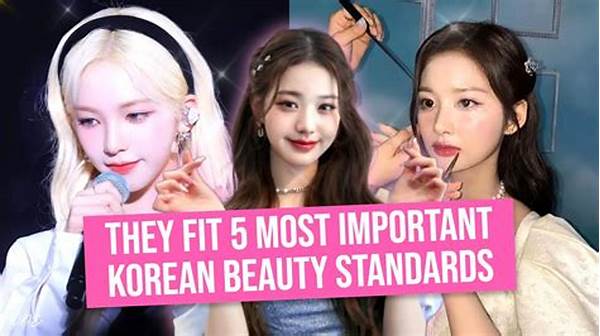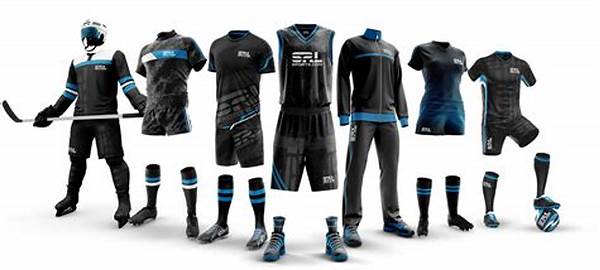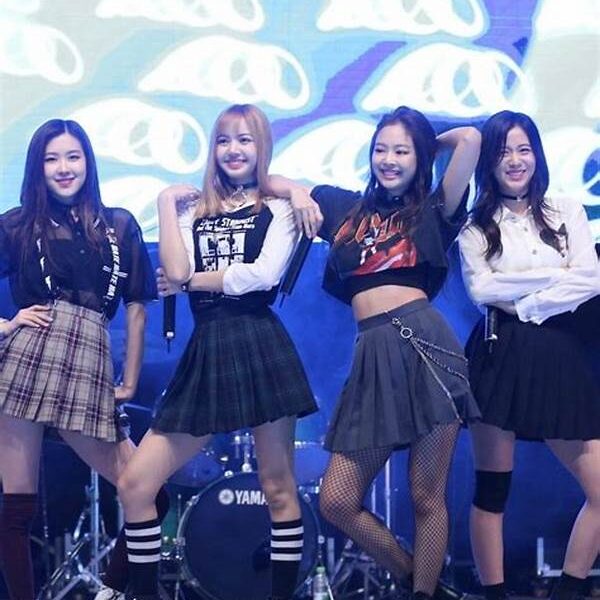Hey there, fellow K-Pop enthusiasts! If you’ve ever delved into the world of K-pop, you know that the industry is famous not just for its catchy tunes and innovative choreography, but also for its emphasis on visuals. Many idols are renowned for their stunning appearances, and there’s an entire set of K-pop idol beauty standards that fans and idols alike seem to aspire to. Today, let’s chat about what these standards look like and why they matter in the glitzy world of Korean pop!
Read Now : K-pop Stars In Pastel Colors
What Defines K-Pop Idol Beauty Standards?
K-pop idol beauty standards are a set of often-unspoken criteria that many believe idols should meet to be considered truly successful. And while beauty is subjective, the industry often leans towards particular traits. Think of attributes like flawless skin, a small face, large eyes, and a slender figure. These are just a few of the traits seen as ideal. It’s fascinating to see how these standards shape the presentation of idols, influencing everything from their photoshoots to stage performances. Of course, these beauty ideals often mirror broader Korean cultural beauty preferences, yet with their own unique K-pop twist.
The reasons behind these strict beauty standards? Well, they’re multifaceted. Partly, it’s about tradition and cultural preferences. There’s also a marketing element, where labels want to present their idols in a way that resonates across international borders, maximizing their global appeal. Yet, it’s crucial to remember that the rise of K-pop has also seen a growing appreciation for individuality. Some idols break the mold, showcasing non-traditional beauty, and fans absolutely adore them for it! Overall, K-pop idol beauty standards provide a framework that many follow, but within that, there’s plenty of room for unique expression and style.
Examples of K-Pop Idol Beauty Standards
1. Flawless Skin: In the world of K-pop, having porcelain-like skin is a must. Many idols work tirelessly to maintain a clear and radiant complexion, adhering closely to the beauty standards that fans adore.
2. V-Line Jaw: A sharp V-line jaw is highly desired in the K-pop industry. It adds to the sleek and youthful appearance that is often celebrated in K-pop idol beauty standards.
3. Big Eyes: One of the most noticeable aspects of K-pop beauty standards is the emphasis on big, expressive eyes. Many idols use makeup techniques to accentuate this feature.
4. Slim Figure: A slender frame is another popular standard, reflecting the preference for slim figures within K-pop idol beauty standards. Many idols adhere to strict diets and routines to achieve this look.
5. Aegyo-Sal: This refers to the cute little bags under the eyes that give a youthful and lively look, fitting perfectly into the K-pop idol beauty standards.
The Pressure of K-Pop Idol Beauty Standards
While these standards might seem glamorous, there’s no denying that they come with a lot of pressure. Numerous idols have spoken openly about the lengths they go to maintain these ideals, from rigorous skincare routines to intense dieting regimens. This pressure can be taxing, not only physically but also mentally. Idols are frequently under the microscope, with every aspect of their appearance carefully scrutinized by fans and the media.
Yet, despite the pressures, there’s a shift happening. More and more, we’re seeing fans who appreciate idols for who they authentically are, beyond their adherence to conventional beauty standards. Social media and fan communities play a big role in this transformation. Fans are celebrating diverse looks and pushing back against the unattainable ideals set by K-pop idol beauty standards. This change in tide brings hope that the industry will eventually value talent and authenticity as much as aesthetics.
Read Now : Fashion Layering Ideas From Jimin
Navigating the K-Pop Idol Beauty Expectations
Here are ten pointers when considering the world of K-pop idol beauty standards:
The Future of K-Pop Idol Beauty Standards
Looking ahead, it seems like the K-pop industry is at a crossroads. On one hand, the traditional beauty standards still hold sway, with many agencies training future idols to meet these ideals. However, the growing global fanbase is starting to dictate new trends. With fans from diverse backgrounds, there is an increasing demand for representation and diversity among idols.
This shift might encourage more idols to embrace their unique traits rather than fit into a one-size-fits-all mold. As the industry increasingly caters to a global audience, there is potential for a broader acceptance of varied beauty standards. This change would not only benefit idols by reducing pressure but also reflect a more authentic picture of beauty in the modern world. Let’s hope that the evolving landscape of K-pop continues to celebrate talent and individuality over narrow beauty norms.
Embracing Individuality Within K-Pop Idol Beauty Standards
Despite the overarching K-pop idol beauty standards, there’s a silver lining: individuality is being welcomed with open arms. More idols are stepping into the spotlight with distinctive features and styles, proving that beauty is multifaceted and should not be confined to a single template. This ongoing evolution in the industry inspires fans and idols alike to embrace their uniqueness.
Idols like Hwasa from Mamamoo and Suga from BTS have challenged traditional beauty norms with their confidence and divergent looks, gaining immense popularity and admiration. Their success stories encourage upcoming idols to showcase their true selves and relish in their individuality. Fans, too, are embracing diverse looks, celebrating the beauty found in different skin tones, body types, and styles. With platforms like social media amplifying their voices, fans are more empowered than ever to support idols who represent real-world diversity.
A Final Reflection on K-Pop Idol Beauty Standards
In conclusion, K-pop idol beauty standards are a fascinating blend of tradition, culture, and commercial appeal. While they contribute to the polished looks we see on stage, it’s essential to recognize their impact on idols’ physical and mental well-being. The industry is slowly shifting towards a more inclusive definition of beauty, paving the way for greater diversity and acceptance.
As fans, supporting idols beyond their appearance and valuing their talents and individuality is paramount. By encouraging an appreciation for diverse beauty, fans can help create a healthier environment for idols to express themselves authentically. Let’s continue to celebrate the captivating world of K-pop while advocating for positive changes in beauty standards that reflect a more diverse and inclusive society.


